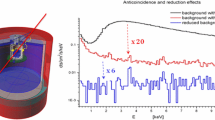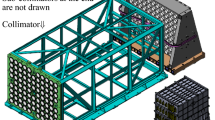Abstract
The enhanced X-ray Timing and Polarimetry mission (eXTP) is a next-generation flagship X-ray astronomy satellite currently in phase-B study. The large Area Detector (LAD) on board eXTP contains 40 modules, each consisting of a set of 4\(\times \)4 large area SDDs and 4\(\times \)4 collimators, and has a designed effective area of 3.0 m\(^2\) at 8 keV and a Field of View (FoV) of 1\(^\circ \). To achieve such a large effective area, the collimator’s Open Area Ratio (OAR) should be greater than 70%. In this paper, we introduce the measurement methods used to determine the OAR and the rocking curve (angular response) of the LAD collimator at the 100-m X-ray Test Facility (100XF) of the Institute of High Energy Physics (IHEP) in Bei**g, and report the results of the collimators manufactured under different conditions. The measured OARs of the collimators are usually smaller than the theoretical values by a few percent, which is due to the non-uniformity and irregularity of the pores. The measured rocking curves are usually broader than the theoretical triangular curves, and the lower the energy of the incident X-ray the broader the rocking curve. This broadening of the rocking curve is the result of reflection on the inner wall of the pores. Our results also show that increasing the etching time in the manufacturing of the collimators can increase the OARs but does not change significantly the shape of the rocking curves.













Similar content being viewed by others
Data Availability
Sequence data that support the findings of this study have been deposited in the IHEP box https://ihepbox.ihep.ac.cn/ihepbox/index.php/s/buEHYMmCuHYeAfN
References
Zhang, S.-N., Santangelo, A., Xu, Y., Feroci, M., Hernanz, M., Lu, F., Chen, Y., Feng, H., Nandra, K., Jiang, W., et al.: Enhanced x-ray timing and polarimetry mission: extp: an update on its scientific cases, mission profile and development status. In: Space Telescopes and Instrumentation 2022: Ultraviolet to Gamma Ray, vol. 12181. pp. 466–495. SPIE, (2022). https://doi.org/10.1117/12.2629340
Feroci, M., Ambrosi, G., Ambrosino, F., Antonelli, M., Argan, A., Babinec, V., Barbera, M., Bayer, J., Bellutti, P., Bertucci, B., et al.: The large area detector onboard the extp mission. In: Space Telescopes and Instrumentation 2022: Ultraviolet to Gamma Ray, vol. 12181. pp. 466–483. SPIE, (2022). https://doi.org/10.1117/12.2628814
Hernanz, M., Brandt, S., Evangelista, Y., Meuris, A., Tenzer, C., Zampa, G., Orleanski, P., Kalemci, E., Sungur, M., Schanne, S., et al.: The wide field monitor onboard the chinese-european x-ray mission extp. In: Space Telescopes and Instrumentation 2022: Ultraviolet to Gamma Ray, vol. 12181. pp. 484–497. SPIE, (2022). https://doi.org/10.1117/12.2628335
Campana, R., Feroci, M., Del Monte, E., Mineo, T., Lund, N., Fraser, G.W.: Background simulations for the large area detector onboard loft. Exp. Astron. 36, 451–477 (2013). https://doi.org/10.1007/s10686-013-9341-6
Turner, M., Smith, A., Zimmermann, H.: The medium energy instrument on exosat. In: X-Ray Astronomy: Proceedings of the XV ESLAB Symposium Held in Amsterdam, The Netherlands, 22–26 June 1981. pp. 513–524. Springer, (1981). https://doi.org/10.1007/BF01246071
Mineo, T., Fraser, G.W., Martindale, A., Feldman, C., Campana, R., Cusumano, G., Feroci, M.: Effects of capillary reflection in the performance of the collimator of the large area detector on board loft. Exp. Astron. 37, 69–84 (2014). https://doi.org/10.1007/s10686-013-9368-8
Zhang, S.-N., Li, T., Lu, F., Song, L., Xu, Y., Liu, C., Chen, Y., Cao, X., Bu, Q., Chang, Z., et al.: Overview to the hard x-ray modulation telescope (insighthxmt) satellite. Sci. China: Phys. Mech. Astron. 63, 1–18 (2020). https://doi.org/10.1007/s11433-019-1432-6
Li, T., Luo, T., Xu, Y., He, H., Song, L.: Study on direct point spread function measurement of capillary plate collimators with divergent x-ray beams. Radiat. Detect. Technol. Methods. 7(3), 321–336 (2023). https://doi.org/10.1007/s41605-023-00411-2
Lombardi, G., Mendes, V., Trois, A., Morgante, G., Ceraudo, F., Piazzolla, R.: The thermo-mechanical design of the module of the lad instrument onboard the extp mission. In: Space Telescopes and Instrumentation 2022: Ultraviolet to Gamma Ray, vol. 12181. pp. 1690–1717. SPIE, (2022). https://doi.org/10.1117/12.2644487
Ceraudo, F., Ge, J., Evangelista, Y., Muleri, F., Hanqi, M., Zhao, X., Wei, X., Feroci, M.: Characterization of the nnvt capillary plate collimators. J. Instrum. 13(09), 09020 (2018). https://doi.org/10.1088/1748-0221/13/09/P09020
Wang, Y., Zhao, Z., Hou, D., Yang, X., Chen, C., Li, X., Zhu, Y., Zhao, X., Ma, J., Xu, H., et al.: The 100-m x-ray test facility at ihep. Exp. Astron. 55(2), 427–445 (2023). https://doi.org/10.1007/s10686-022-09872-7
Hou, D., Wang, Y., Zhao, Z., Zhao, X., Yang, X., Ma, J., Zhu, Y., Xu, Y., Chen, Y., Liu, C., et al.: Characterization of a pnccd-based camera for applications at the 100 m x-ray test facility. Publ. Astron. Soc. Pac. 135(1048), 064505 (2023). https://doi.org/10.1088/1538-3873/acdf20
Acknowledgements
The Chinese team acknowledges support by the Chinese Academy of Sciences through the Strategic Priority Research Program, Grant No. XDA15020500. This work is partially supported by International Partnership Program of Chinese Academy of Sciences (Grant No.113111KYSB20190020).
Author information
Authors and Affiliations
Contributions
Zijian Zhao led the experimental design, equipment operation, and data analysis of the study, and also wrote the first draft of the paper. Tao Luo assisted in experimental design and designed the aluminum holder for the MCPs, optimizing the overall process. Francesco Ceraudo and Marco Feroci provided simulation data, valuable suggestions for optimizing data analysis and improving the manuscript. Longhui Li and Jian Wang provided the four MCPs with different roughness. Shuang-Nan Zhang, Fangjun Lu, Yupeng Xu, and Yusa Wang offered guidance and supervision for the manuscript. Hongwei Liu, Huilin He, Yuxuan Zhu, Yifan Zhang, Dongjie Hou, and **ongtao Yang were responsible for data recording during the test and provided valuable suggestions for the manuscript. All authors have reviewed and approved the final manuscript.
Corresponding authors
Ethics declarations
Competing interests
The authors declare no competing interests.
Rights and permissions
Springer Nature or its licensor (e.g. a society or other partner) holds exclusive rights to this article under a publishing agreement with the author(s) or other rightsholder(s); author self-archiving of the accepted manuscript version of this article is solely governed by the terms of such publishing agreement and applicable law.
About this article
Cite this article
Zhao, Z., Luo, T., Ceraudo, F. et al. Characterization of the eXTP-LAD collimators. Exp Astron 57, 29 (2024). https://doi.org/10.1007/s10686-024-09947-7
Received:
Accepted:
Published:
DOI: https://doi.org/10.1007/s10686-024-09947-7




